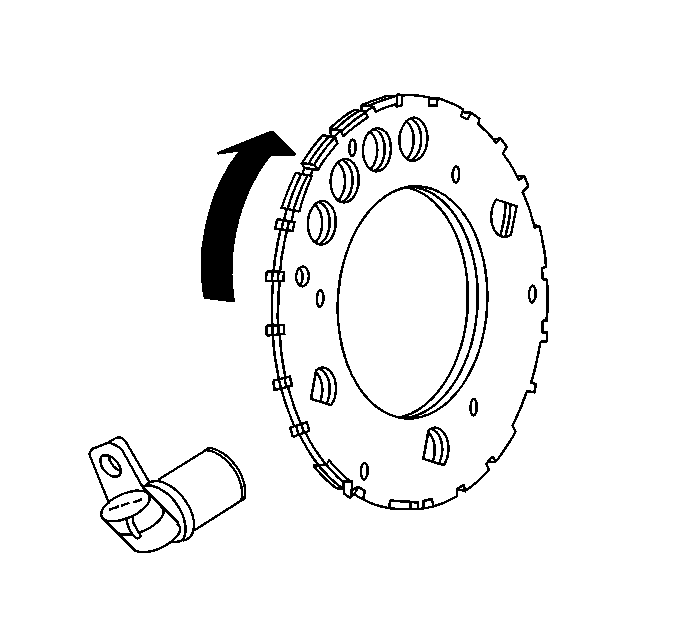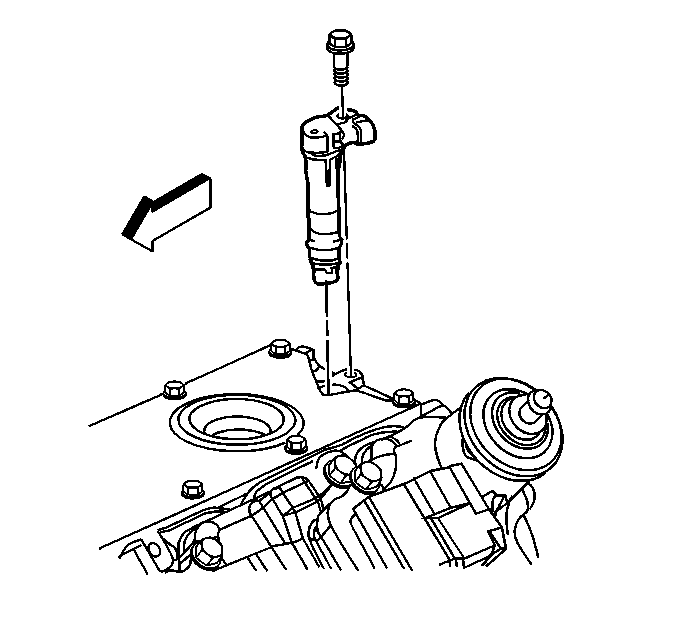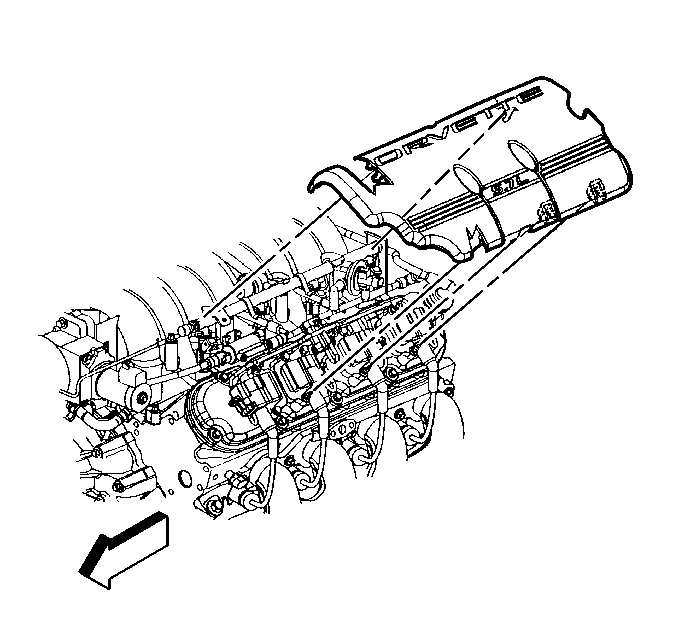Ignition System Overview
The electronic ignition system controls fuel combustion by providing
a spark to ignite the compressed air/fuel mixture at the correct time. To
provide optimum engine performance, fuel economy, and control of exhaust emissions,
the PCM controls the spark advance of the ignition system. The Electronic
ignition system has the following advantages over a mechanical distributor
system:
| • | Remote mounting capability. |
| • | No mechanical load on the engine. |
| • | More coil cool down time between firing events. |
| • | Elimination of mechanical timing adjustments. |
| • | Increased available ignition coil saturation time. |
The electronic ignition system does not use the conventional
distributor and coil. The ignition system consists of the following components/circuits:
| • | Eight ignition coils/modules |
| • | Eight Ignition Control (IC) circuits |
| • | Camshaft Position (CMP) sensor |
| • | 1X Camshaft reluctor wheel |
| • | Crankshaft Position (CKP) sensor |
| • | 24X Crankshaft reluctor wheel |
| • | Related connecting wires |
| • | Powertrain Control Module (PCM) |
Crankshaft Position Sensor and Reluctor Wheel

The Crankshaft Position (CKP) sensor is located in the right rear of the engine,
behind the starter. The CKP sensor is a dual magneto resistive type sensor.
This sensor is not speed dependent. The dual micro switches monitor both notches
of the reluctor wheel for greater accuracy. The CKP sensor works in-conjunction
with a 24X reluctor wheel. The reluctor wheel is mounted on the rear of the
crankshaft. The 24X reluctor wheel uses two different width notches that are
15 degrees apart. This Pulse Width Encoded pattern allows cylinder position
identification within 90 degrees of crankshaft rotation. In some cases, cylinder
identification can be located in 45 degrees of crankshaft rotation. This reluctor
wheel also has dual track notches that are 180 degrees out of phase. The dual
track design allows for quicker starts and accuracy.
The PCM also receives a 4X signal from the Crankshaft Position sensor.
The PCM utilizes the 4X signal for the following:
The CKP signal must be available for the engine to start. The CMP signal
is not needed to start and operate the engine. The PCM can determine when
a particular cylinder is on either a firing or exhaust stroke by the 24X signal.
The CMP sensor is to determine what stroke the engine is on. The system will
attempt synchronized and look for an increase in the MAF signal. An increase
in the MAF signal indicates the engine has started. If the PCM does not detect
an increase in the MAF signal, a re-sync will occur to the opposite cam position.
A slightly longer cranking time may be a symptom of this condition.
Camshaft Position Sensor

The Camshaft Position (CMP) sensor is mounted through the top of the engine
block at the rear of the valley cover. The CMP sensor works in-conjunction
with a 1X reluctor wheel. The reluctor wheel is located at the rear of the
camshaft. The CMP sensor is used to determine whether a cylinder is on the
firing or the exhaust stroke. As the camshaft rotates, the reluctor wheel
interrupts a magnetic field produced by a magnet within the sensor. The CMP
sensor internal circuitry detects this and produces a signal which is used
by the PCM. The PCM uses this signal in combination with the CKP 24X signal
to determine crankshaft position and stroke.
The CKP signal must be available for the engine to start. The CMP signal
is not needed to start and operate the engine. The PCM can determine when
a particular cylinder is on either a firing or exhaust stroke by the 24X signal.
The CMP sensor is to determine what stroke the engine is on. The system will
attempt synchronized and look for an increase in the MAF signal. An increase
in the MAF signal indicates the engine has started. If the PCM does not detect
an increase in the MAF signal, a re-sync will occur to the opposite cam position.
A slightly longer cranking time may be a symptom of this condition.
Ignition Coils/Module

The ignition system on this vehicle features a multiple coil ignition and
is known as coil near plug. The secondary ignition wires are short
compared with a distributor ignition system wire. Eight ignition coils/modules
are individually mounted above each cylinder on the rocker covers. The coils/modules
are fired sequentially. There is an Ignition Control (IC) circuit for each
ignition coil/module. The eight ignition control circuits are connected to
the PCM. All timing decisions are made by the PCM, which triggers each coil/module
individually. The ignition coil/modules are supplied with the following circuits:
| • | Ignition control circuit |
The ignition feed circuits are fused separately for each bank of the
engine. The two fuses also supply the injectors for that bank of the engine.
Each coil/module is serviced separately.
This system puts out very high ignition energy for plug firing. Because
the ignition wires are shorter, less energy is lost to ignition wire resistance.
Also, since the firing is sequential, each coil has seven events to saturate
as opposed to the three in a waste spark arrangement. Futhermore, no energy
is lost to the resistance of a waste spark system.
Circuits Affecting Ignition Control
To properly control ignition timing, the PCM relies on the following
information:
| • | Engine load (manifold pressure or vacuum) |
| • | Atmospheric (barometric) pressure |
The Ignition Control (IC) system consists of the following components:
| • | 24X crankshaft position sensor |
| • | Powertrain Control Module (PCM) |
The Ignition Control utilizes the following to control spark timing
functions:
| • | 24X signal - The 24X crankshaft position sensor sends a
signal to the PCM. The PCM uses this signal to determine crankshaft position.
The PCM also utilizes this signal to trigger the fuel injectors. |
| • | Ignition Control (IC) circuits - The PCM uses these circuits
to trigger the ignition coil/modules. The PCM uses the crankshaft reference
signal to calculate the amount of spark advance needed. |
Noteworthy Ignition Information
There are important considerations to point out when servicing the ignition
system. The following Noteworthy Information will list some of these, to help
the technician in servicing the ignition system.
| • | The ignition coils secondary voltage output capabilities are very
high - more than 40,000 volts. Avoid body contact with ignition
high voltage secondary components when the engine is running, or personal
injury may result! |
| • | The 24X crankshaft position sensor is the most critical part of
the ignition system. If the sensor is damaged so that pulses are not generated,
the engine will not start! |
| • | Crankshaft position sensor clearance is very important! The sensor
must not contact the rotating interrupter ring at any time, or sensor damage
will result. If the interrupter ring is bent, the interrupter ring blades
will destroy the sensor. |
| • | Ignition timing is not adjustable. There are no timing marks on
the crankshaft balancer or timing chain cover. |
| • | Be careful not to damage the secondary ignition wires or boots
when servicing the ignition system. Rotate each boot to dislodge it from the
plug or coil tower before pulling it from either a spark plug or the ignition
coil. Never pierce a secondary ignition wire or boot for any testing purposes!
Future problems are guaranteed if pinpoints or test lights are pushed through
the insulation for testing. |
Powertrain Control Module (PCM)
The PCM is responsible for maintaining proper spark and fuel injection
timing for all driving conditions. To provide optimum driveability and emissions,
the PCM monitors input signals from the following components in calculating
Ignition Control (IC) spark timing:
| • | Engine Coolant Temperature (ECT) sensor. |
| • | Intake Air Temperature (IAT) sensor. |
| • | Mass Air Flow (MAF) sensor. |
| • | Trans Range inputs from Transaxle Range switch. |
| • | Throttle Position (TP) sensor. |
| • | Vehicle Speed Sensor (VSS). |
Results of Incorrect Operation
An Ignition control circuit that is open, grounded, or short to voltage
will set an ignition control circuit DTC. If a fault occurs in the IC output
circuit when the engine is running, the engine will experience a misfire.
DTCs P0351-P0358 will set when a malfunction is detected with an Ignition
Control circuit. When an Ignition control DTC sets, the PCM will disabled
the injector for the appropriate cylinder.
The PCM uses information from the engine coolant temperature sensor
in addition to RPM to calculate spark advance values as follows:
| • | High RPM = more advance |
| • | Cold engine = more advance |
| • | Hot engine = less advance |
Therefore, detonation could be caused by high resistance in the engine
coolant temperature sensor circuit. Poor performance could be caused by low
resistance in the engine coolant temperature sensor circuit.
If the engine cranks but will not run or immediately stalls,
Engine Cranks But Will Not Run diagnostic table must be used to determine
if the failure is in the ignition system or the fuel system. If DTC P0300,
P0341, P0342, P0343, P0335, P0336 is set, the appropriate diagnostic trouble
code table must be used for diagnosis.



